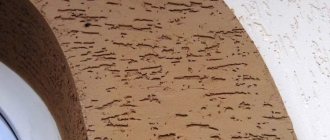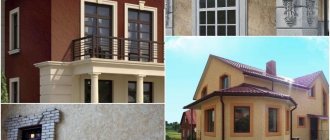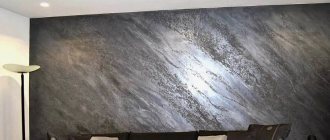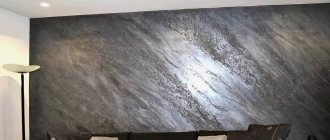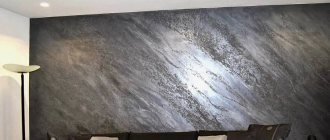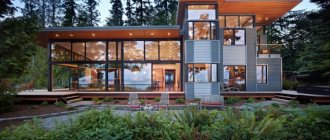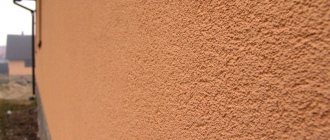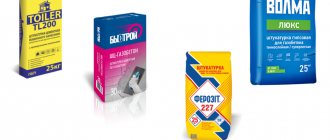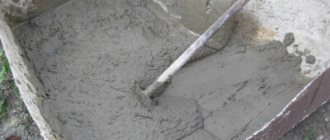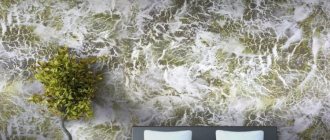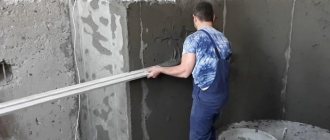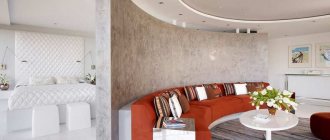It is not easy for an inexperienced builder to make such a responsible decision about the choice of material for finishing external walls. Arriving at a hardware store, most consumers' eyes widen: what is better to choose?
Vapor-permeable facade plaster is one of the most popular solutions on the market today.
Unfortunately, many buyers do not know how to properly use such material, what tools to use, what are the advantages of vapor-permeable coating, and why has it suddenly become so popular. Let's try to further understand these exciting issues.
What is vapor permeability of plaster
The vapor permeability of plaster is a criterion that evaluates the ability of a material to transmit steam and air.
It’s not for nothing that plasters with a high vapor permeability rate are called “breathable”: vapor-permeable plaster does not allow condensation to accumulate inside the room. This is undoubtedly its huge advantage, because excessive humidity leads to the formation of mold and mildew on the walls (which can cause allergies and other diseases in both children and adults), and deterioration of the building’s supporting structure. In addition, when a large amount of moisture is regularly absorbed into the facade of a house, frost resistance indicators greatly deteriorate. Thus, the vapor permeability of walls directly affects the comfort of everyone living in the house.
Gypsum compositions
Conventional gypsum compositions are not used for finishing basements and damp rooms. Gypsum, with its pores, easily absorbs moisture from the air and, as a result, loses its qualities. However, according to manufacturers and builders, you can safely cover ceilings and walls even in the bathroom with moisture-resistant gypsum plaster.
In rooms plastered with waterproof gypsum mortar, mirrors do not fog up and it is easier to breathe.
The use of plaster gypsum mixtures also follows from the general rule that stronger plaster cannot be applied to a weak base. But in many modern new buildings the bathrooms themselves are made of gypsum material. In fact, the gypsum base is plastic, molded and shaped well. It is possible to create thin patterned reliefs.
The most popular ready-made CCs are Teplon Unis and Knauf Rotband. Water resistance is imparted to ordinary gypsum by impregnating the coating with water-repellent primers or by adding PVA (glue) to the solution.
But still, not everything is so rosy with gypsum mixtures. Even specially developed additives do not completely eliminate the ability of gypsum to actively absorb moisture. Perhaps in the near future, reliable waterproof gypsum mixtures will appear. In the meantime, you need to be careful with them. The humidity in toilet rooms is lower than in bathrooms. Gypsum mixture can be used there. It is only necessary to cover with waterproofing areas of the wall or ceiling where direct contact with water is possible.
Types of vapor-permeable plasters
Today on the market there are such varieties of vapor-permeable plasters for use in finishing facades, such as:
1. Mineral plaster. As a rule, professional builders prefer this type. Contains sand and cement. Resistant to ultraviolet radiation and mold formation. Quite easy to apply to the wall. Mineral plaster has a fairly low cost due to the available raw materials, but at the same time it has excellent vapor permeability. Many also note the durability and resistance of this coating.
2. Silicate plaster. Liquid glass is added to it, which ensures the highest level of vapor permeability. Does not accumulate dust. Prevents the development of fungus. Unfortunately, when exposed to moisture, silicate plaster may slightly change its shade, but after drying the color returns to normal.
3. Silicone plaster. This mixture contains silicone resin. This plaster has excellent vapor permeability. Silicone coating is also completely unaffected by high humidity. The stores offer a wide variety of shades and textures. The disadvantages are the high cost of the coating and the complexity of its application.
4. Gypsum based. To use this material, no preliminary preparation of surfaces is required. In addition, the price of this plaster is quite affordable.
Acrylic plasters have very low vapor permeability, so they should not be considered if this indicator is fundamentally important. But this type of coating has good elasticity and resistance to mechanical damage.
Many experts recommend choosing vapor-permeable plasters for external use with the possibility of grouting, since they contain a sufficient amount of polymers. However, here everyone chooses the appropriate option for themselves, based on the individual characteristics of living conditions, cost, characteristics and availability of one or another type of coverage.
Features of the material
Sanitating plasters, unlike traditional cement-sand mortars, have 3 technical and operational properties that are characteristic only of them:
- Creation of an effective waterproofing layer.
- Ensuring resistance to precipitation of sulfate salts.
- Prevention of the formation of efflorescence on the surface.
Operating principle of the protective layer:
- Initially, moisture from the base passes into the porous sublayer, where sulfate efflorescence is retained.
- Moisture comes out through the pores and evaporates from the second layer of cladding.
- The finishing coating, after hardening, forms a reliable waterproofing film that prevents the passage of moisture through the finish.
But, you need to know that hydrophobic sanitizing plaster is not intended for application to a gypsum surface.
Tools for work
Tools for plastering walls will help you apply the material efficiently and evenly. To lay plaster on the facade of a building, craftsmen use the following tools:
- Trowel, ladle or trowel for initial placement of material.
- A grater for subsequent grouting of walls.
- The lath is then used to check how well the plaster has been applied. To do this, it is applied both vertically and horizontally. The maximum permissible deviations are no more than 7 millimeters.
- The polisher will help get rid of the remaining mortar on the walls.
- Beacons are installed to eliminate various irregularities on the surface.
- Use a hammer to knock off the old plaster layer from the walls, and also tap the mortar.
- Mixing container.
- Gloves for skin protection.
- A mixer or a special attachment for an electric drill to mix the mixture.
- Sandpaper (preferably coarse grain).
- The rule controls the alignment of the corners.
Finishing
Moisture-resistant compounds are also used for finishing. You can create a smooth, even coating due to the plasticity of the material.
Finishing can be in the form of:
- glued tiles;
- painting with waterproof paints;
- an additional plaster layer made with textured decorative waterproof plaster.
A Venetian varnish coated with a composition that is not afraid of water looks great in the bathroom. The plaster coating can be embossed, but it is more often contaminated and favored by microfauna or microflora.
When applying textured decorative mixtures, wall or ceiling coating techniques are used, similar to the application of conventional decorative mixtures.
Rules for working with vapor-permeable plasters
The finishing process is practically no different from working with other types of plasters.
First, you need to clean the wall surface from dirt, dust, and eliminate unevenness. If there are cracks or other damage in the walls, these also need to be repaired.
After preparation, the surfaces should be primed. At this stage you need to be patient and let the primer dry thoroughly.
The next stage is layer reinforcement. This is done using a reinforcing mesh made of special fiberglass. You should not skimp on this process, since a low-quality mesh will quickly collapse under the influence of the highly alkaline composition of the plaster. Please note that wood concrete does not require wall reinforcement.
If vapor-permeable plaster was used to decorate the facades of the house, then the internal walls of the building should also be covered with this type of material.
In hot weather, the applied product is periodically moistened with clean water. This is done in order to avoid cracks on the surface of the coating and its uneven drying.
The inner layer of plaster should be twice as thick as the outer one.
During operation, the air temperature cannot be lower than 5 degrees Celsius.
Recommendations for choosing formulations
When the question of choice arises, they are guided by the following parameters:
- scope and purpose (for indoor plaster or for external work, finishing or leveling);
- base material (select a mixture on an appropriate basis);
- possible decorative effect (Venetian, fur coat, etc.);
- method of application (mechanized, manual);
- financial opportunities.
So, for subsequent tiling, a plaster base is required that can support the weight of the tile. Cement-polymer or cement mixtures cope well with this.
If you plan to paint a paint coating, mixtures such as Knauf or Zeresit designed for wet rooms are suitable.
Cement mixtures
Cement mixtures are made from cement and sand with the addition of hydrophobic modifying additives and plasticizers.
Cement plasters for wet rooms are highly durable and water resistant.
It is better to purchase ready-made dry mixtures, presented in a wide range on the construction market, in which all components are perfectly balanced:
- EC waterproofing mixture, for plastering on stone and brick;
- Ceresit CR 65 - for any base;
- AZOLIT-VSH - for finishing on concrete and brick;
- Profit Gidrofob for applying an additional waterproofing layer on plastered bases;
- Murexin Waterproofing Hydro Basic 1K, suitable for all substrates;
This solution should be prepared in accordance with the recommendations on the packaging, using a construction mixer or a hammer drill with an attachment for mixing.
To make cement mortar with your own hands, you need to take a mixture of cement and sand in a ratio of 1:3, add PVA glue to increase water resistance and washing powder to increase ductility.
Preparing walls before application
Here everything is done in the same way as before applying other types of plasters, for example cement:
- the walls are cleaned of previous coatings that have become unusable, or peeling areas are removed;
- where brick is used in the masonry of the walls, the masonry seams are expanded and deepened to increase adhesion;
- repair large punctures, “treat” cracks;
- disinfect foci of mold and fungal infection using a biocidal composition;
- eliminate efflorescence;
- degrease oil stains;
- get rid of rust;
- concrete, as well as other bases, are primed twice to increase adhesion and prevent dehydration of the solution by absorption of moisture from it by the wall material;
- the base is dried;
- To apply a thick layer, beacons are installed.
Wooden walls for plastering are covered with shingles. You can use reinforcing mesh for better adhesion.
Common Mistakes
The finished coating can be prepared for the use of decorative materials. Before painting, the surface is treated with a brush with soft metal bristles and a characteristic roughness is achieved. Texture is necessary to create adhesion when applying primer in 2-3 layers. But first you need to find out the moisture content of gypsum plaster. It should not exceed 1%. A moisture meter is used for measurements.
Inexperienced finishers often ignore the basic rules for using gypsum plaster. The following are common mistakes that will negatively affect the quality of work:
- Applying a thick layer instead of 2 small layers. In this case, the solution will dry unevenly or slide off;
- Mixing with additives not specified in the instructions or preparing the mixture according to recommendations from a friend. Such amateurism often leads to sad results when the service life of the plastered surface is noticeably reduced;
- Adding a new portion to the remnants of the previous composition. In this example, a violation of the adhesive properties of the material and further crumbling and shedding are possible;
- Temperature violation. It is advisable to carry out finishing work at temperatures from 5 to 25°C. Otherwise, the gypsum plaster will begin to harden, lose its unique properties and will not fit well on the wall, which will inevitably lead to cracking.
- In extreme heat, it is also better to postpone plastering the surfaces. Too rapid evaporation of moisture from the solution will lead to disruption of the crystal lattice and the formation of a characteristic cobweb.
- Applying the mixture to a dry or too wet surface. If an inexperienced finisher does exactly this, there is no talk of reliable adhesion. The material will begin to swell and gradually fall off.
A smooth base should be made matte, and a too rough base should be coated with 2 layers of primer.
The best brands
Perlite is an inexpensive material, so the following mixtures are readily used (GK Unis):
- Gypsum SS Teplon Unis (white) of domestic production is no worse than imported analogues. The dried coating has a snow-white color. After sanding the surface of the coating, wallpaper is glued onto it or painted over. This mixture can be applied in a layer of up to 5 cm per pass. Used indoors. The setting time of the solution is 50 minutes. The gypsum composition is applied mechanically or manually.
- Extra Gips Izo (Türkiye) contains gypsum as a base. Manual application in layers up to 70 mm without mesh. Sets quickly. Lifetime – 30 minutes. 50 minutes after application and leveling, the coating is polished with a steel trowel until it shines.
- CC Glims Velur is resistant to cracking and elastic. Apply in layers up to 35 mm. Can be smoothed to a glossy finish. Suitable for manual and mechanical application. Universal use.
- Also popular are Knauf Grünband, Umka and Mishka.
